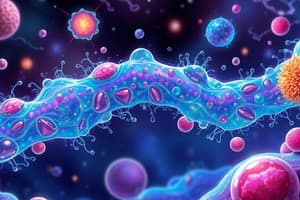Podcast
Questions and Answers
Which type of essential nutrient is required in large quantities to synthesize macromolecules?
Which type of essential nutrient is required in large quantities to synthesize macromolecules?
- Growth Factors
- Macronutrients (correct)
- Micronutrients
- Trace Elements
What distinguishes heterotrophs from autotrophs in terms of carbon sources?
What distinguishes heterotrophs from autotrophs in terms of carbon sources?
- Autotrophs do not require carbon sources.
- Autotrophs rely on organic carbon sources.
- Heterotrophs require organic carbon sources. (correct)
- Heterotrophs use inorganic carbon sources.
Which of the following is a way some organisms acquire nitrogen?
Which of the following is a way some organisms acquire nitrogen?
- Directly consuming carbohydrates
- Nitrogen fixation from atmospheric N2 (correct)
- Sourcing nitrogen from lipids
- Absorbing oxygen from organic compounds
Which essential nutrients are considered micronutrients?
Which essential nutrients are considered micronutrients?
From where do phosphorus sources primarily originate?
From where do phosphorus sources primarily originate?
Which source is a common origin for essential sulfur nutrients?
Which source is a common origin for essential sulfur nutrients?
What kind of compounds are considered growth factors for microbes?
What kind of compounds are considered growth factors for microbes?
Which type of microorganisms gain energy from chemical compounds?
Which type of microorganisms gain energy from chemical compounds?
What type of heterotroph derives its carbon and energy from organic compounds obtained from other organisms?
What type of heterotroph derives its carbon and energy from organic compounds obtained from other organisms?
Which type of saprobic microorganism cannot live in a host and must rely solely on dead organic matter?
Which type of saprobic microorganism cannot live in a host and must rely solely on dead organic matter?
What term describes the process of water moving through a selectively permeable membrane?
What term describes the process of water moving through a selectively permeable membrane?
What happens to a cell placed in a hypotonic solution?
What happens to a cell placed in a hypotonic solution?
What characterizes an obligate parasite?
What characterizes an obligate parasite?
Which mechanism is used to move small, non-polar molecules through the plasma membrane?
Which mechanism is used to move small, non-polar molecules through the plasma membrane?
What is the definition of tonicity in relation to cells?
What is the definition of tonicity in relation to cells?
Which statement best describes a facultative parasite?
Which statement best describes a facultative parasite?
Flashcards are hidden until you start studying
Study Notes
Microbial Nutrition
- Nutrition involves the uptake of nutrients from the environment for metabolism and growth.
- Essential nutrients are required because organisms cannot synthesize them.
- Macronutrients (C, H, O, N, K, P, S) are needed in large quantities to form macromolecules (nucleic acids, proteins, carbohydrates, lipids).
- Micronutrients (trace elements like Zn, Mn) are crucial in smaller amounts for enzyme activity and protein structure.
Sources of Essential Nutrients
- Essential nutrients originate from inorganic reservoirs (rocks, atmosphere, oceans), and many organisms acquire nutrients from others that have already incorporated them.
- Carbon sources vary:
- Heterotrophs require organic carbon sources (e.g., glucose).
- Autotrophs utilize inorganic carbon (CO2), functioning as self-feeders.
- Nitrogen sources include nitrogen fixation (converting N2 gas to NH3) and the breakdown of molecular compounds (DNA, RNA, ATP).
- Oxygen sources come from the atmosphere (20% O2), organic compounds, and inorganic salts (phosphates, nitrates, sulfates).
- Hydrogen sources are environmental gases such as H2S, CH4, and H2.
- Phosphorus is obtained through weathering of rocks and sediment as phosphate.
- Sulfur also derives from weathering geological formations.
- Other important nutrients in microbial metabolism include K, Na, Ca, Fe, Mg, and Zn.
- Growth factors are vital organic compounds (amino acids, vitamins, nitrogenous bases) that cannot be synthesized and must be ingested.
Nutritional Types of Microbes
- Nutritional types are determined by the carbon and energy sources utilized.
- Phototrophs derive energy from photosynthesis (not covered in this course).
- Chemotrophs obtain energy from chemical compounds:
- Chemoheterotrophs utilize organic compounds for both carbon and energy (e.g., aerobic respiration).
- Saprobic microorganisms feed on dead organic matter:
- Obligate saprobes cannot live in a host and thrive in free-living conditions.
- Facultative parasites infect a host when the immune system allows (opportunistic pathogens).
- Parasitic microorganisms depend entirely on hosts:
- Pathogens can cause disease or death.
- Obligate parasites cannot survive without a host (e.g., syphilis bacterium).
- Obligate intracellular parasites require host cells for part or all of their lifecycle (e.g., viruses).
Transport Mechanisms for Nutrient Absorption
- Organisms utilize multiple mechanisms to move nutrients in and waste out:
- Diffusion: Movement of substances from high concentration to low until equilibrium is reached; effective for small, non-polar molecules (O2, CO2).
- Osmosis: Movement of water through a selectively permeable membrane from areas of high water concentration to low.
- Cell walls allow large water movement, and small water molecules can pass through plasma membranes.
- Selectively permeable membranes permit movement based on size and charge.
- Tonicity influences water movement:
- Hypotonic: Solute concentration outside the cell is lower, resulting in water influx.
- Hypertonic: Solute concentration outside is higher, leading to water movement out of the cell.
- Isotonic: Equal solute concentrations outside and inside, resulting in no net water movement.
Studying That Suits You
Use AI to generate personalized quizzes and flashcards to suit your learning preferences.




